SUBFAMILY CERAPACHYINAE - Genus Simopone Forel
| The Ants of Africa SUBFAMILY CERAPACHYINAE - Genus Simopone Forel |
Diagnostic Features - Tibial spurs absent from the middle legs, claws usually with a single preapical tooth.
Forel's (1891b) genus definition is at ![]() .
.
Bolton (1973a) described this as a genus of rare, arboreal and mainly nocturnal ants, nesting in hollow twigs or rotten branches. Kutter (1976) noted that 7 species were known from tropical Africa (according to Brown, 1975). Brown (1975) noted that the food habits were unknown. Bolton (1990a) gives a total of nine species from Africa, without giving any names.
Menozzi (1930b) recorded a single specimen of what he felt was a
distinctive form of Simopone from Somalia, but, as the
specimen lacked antennae, he hesitated to give more than a cursory
description - this is at ![]() .
.
Note: Bolton & Fisher (2012) have revised the genus and postulated a total of 18 species from the Afrotropics, with several new species. Their key, however, appears to require observations, e.g. the possibility to be able to see whether or not there is an incised transverse sulcus (groove) on the mesopleuron, that are too demanding for the non-specialist worker. Their glossary uses mesosoma for alitrunk; AII for petiole, AIII for postpetiole and AIV for first gaster segment, etc. Such terminology all maybe puristically correct but, for me, is simply unnecessary and, worse, confusing.
On the schoutedeni-group they had (terminology changed as noted above: The eleven species are best separated by the characters in the key, but at least one alternative system may be used. Seven of the eleven species have fine ground sculpture on the head between the eyes that is arranged into minute, irregular, roughly parallel longitudinal striolae or costulae, usually right across the interocular space. These minute costulae run between, and sometimes through, the broad shallow foveolate punctures that also occur in this area. Of the seven, fulvinodis is immediately isolated by its unique colour pattern and dryas by its long, narrow postpetiole and its small, relatively anteriorly located eyes. Of the remaining five species in this complex, schoutedeni is the only one to exhibit petiole with parallel straight sides in dorsal view, so that the anterior and posterior widths of petiole are almost exactly the same. In amana, annettae and wilburi the anterior width of petiole is less than the posterior width, often obviously so, and all three are smaller than schoutedeni. S. wilburi has larger, more prominent eyes than amana and annettae, and annettae has petiole broader than long, whereas in wilburi and amana petiole is longer than broad.The other four species lack conspicuous longitudinally arranged ground sculpture between the eyes, but small patches of disorganised microsculpture may be present, and even one or two tiny, isolated longitudinal striolae may occur. Of these, miniflava is quickly isolated by its uniformly yellow colour and brunnea has the punctures on the tergite of postpetiole reduced to widely separated pin-pricks, rather than the closely packed foveolate punctures that are more characteristic of the group. S. vepres is larger than occulta (e.g. HW 0.69 versus 0.49) and has larger, more prominent eyes. In addition, petiole in vepres is broader posteriorly than anteriorly, whereas in occulta the two widths are almost exactly the same.
Their species-grouping has three relevant groups:
With weak or absent, if present short, genal carinae (parafrontal ridge).
The emery-group (relatively large and thickset; HW 0.74-2.18; mandibles at least feebly sculptured; pygidium with a distinct apical fork): with conradti, grandis, latiscapa, marleyi, matthiasi and persculpta.
With well-defined genal carinae extending back to the eye.
The grandidieri-group
(frontal carinae diverge from point of origin on frontal lobes): laevissima (the only genus member
with funiculus segments 4-6 at least as long as broad) [images of the
Madagascar species elegans available].
The schoutedeni-group (relatively small and uncommon; HW 0.46-0.80; mandibles smooth; eye with numerous but conspicuous short hairs [setae] between the ommatidia; small area of pale cuticle on lateral pronotum; pygidium with only a small apical fork): amana, annettae, brunnea, dryas, fulvinodis, miniflava, occulta, rabula, schoutedeni, vepres, and wilburi.
Key to workers known from Africa (developed from Brown,
1975 ![]() and Bolton & Fisher (2010).
and Bolton & Fisher (2010).
| 1 |  Frontal carinae long and diverging from
point of origin on frontal lobes Frontal carinae long and diverging from
point of origin on frontal lobesTL 7.0 mm; HL 1.24, HW 0.97; head only slightly longer than broad with frontal carinae reaching back to the level of the eyes; few erect, long yellowish hairs more abundant on gaster; jet black, polished |
. |
| . | 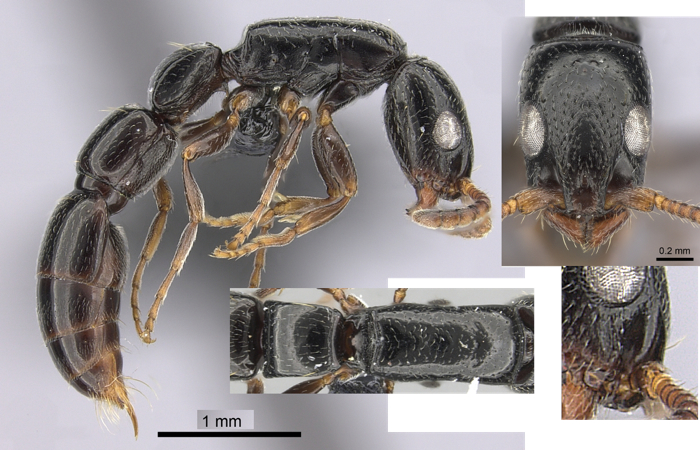 Simopone elegans
(Madagascar) for comparision Simopone elegans
(Madagascar) for comparision |
Uganda - laevissima |
| -- |
Frontal carinae short and not diverging from point of origin on frontal lobes | 2 |
| 2 | 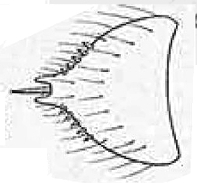 With
weak or absent, if
present short, genal carinae; relatively
large and thickset; HW 0.74-2.18; mandibles at least feebly sculptured;
pygidium with a distinct apical fork With
weak or absent, if
present short, genal carinae; relatively
large and thickset; HW 0.74-2.18; mandibles at least feebly sculptured;
pygidium with a distinct apical fork |
emeryi-gp - 3 |
| -- | 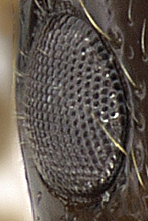 Relatively
small and uncommon; HW 0.46-0.80;
mandibles smooth; eye
with numerous but conspicuous short hairs [setae] between the
ommatidia; small area of pale cuticle on lateral pronotum; pygidium
with only a small apical fork Relatively
small and uncommon; HW 0.46-0.80;
mandibles smooth; eye
with numerous but conspicuous short hairs [setae] between the
ommatidia; small area of pale cuticle on lateral pronotum; pygidium
with only a small apical fork |
schoutedeni-gp - 7 |
| emery-group - conradti, grandis, latiscapa, marleyi, matthiasi and persculpta | . | |
| ¤ | Queen only known; TL ca 5
mm; HW 0.8, HL 1.0, CI 80, SL 0.35; dark brown, appendages dull yellow
- images on species page |
Cameroun - matthiasi |
| 3 |  TL
5.5 mm HL 1.28–1.80, HW 0.78–1.10; clypeus with a median carina, and
lateral carinae which extend
back as frontal carinae but these only reach about two-thirds of the
way back to the level of the eyes; most of dorsum of head, dorsum of
head, petiole and postpetiole finely, longitudinally striate and
subopaque; very few erect hairs; black with rust appendages TL
5.5 mm HL 1.28–1.80, HW 0.78–1.10; clypeus with a median carina, and
lateral carinae which extend
back as frontal carinae but these only reach about two-thirds of the
way back to the level of the eyes; most of dorsum of head, dorsum of
head, petiole and postpetiole finely, longitudinally striate and
subopaque; very few erect hairs; black with rust appendages |
. |
| . | 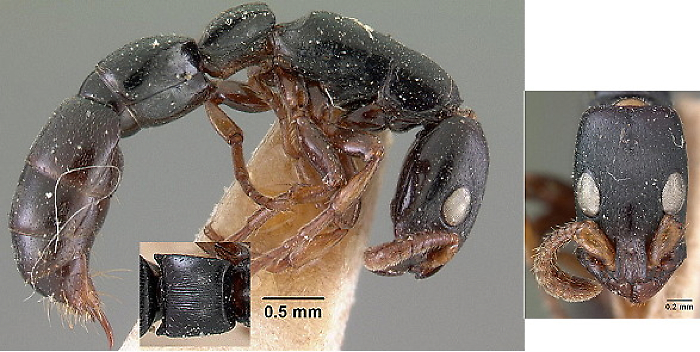 |
West Africa - conradti |
| -- | 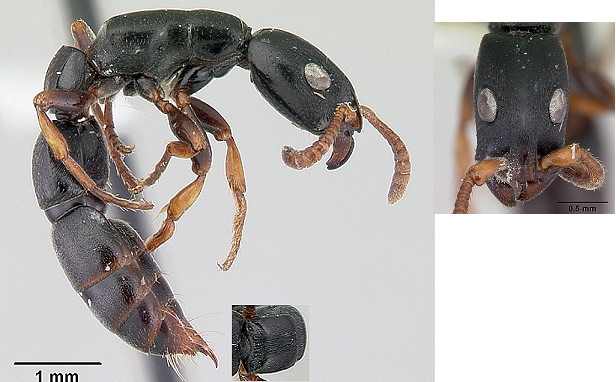 TL > 7 mm;
considerably bigger, with straighter sides to the head; generally
smoother and shinier TL > 7 mm;
considerably bigger, with straighter sides to the head; generally
smoother and shinier |
Simopone conradti ? Kenya link wrong - CASENT0178214.htm |
| -- |
Dorsum of petiole and
postpetiole smooth; clypeus without a median prominence |
4 |
| 4 | Dorsal and lateral surfaces of alitrunk and pedicel conspicuously blanketed with fine, dense, microreticulate to reticulopunctate ground sculpture | 5 |
| -- |
Dorsal and lateral surfaces of
alitrunk and pedicel smooth or nearly so |
6 |
| 5 |  Dorsum
of head between frontal carinae, and back between the eyes, with fine
longitudinal costulate sculpture that is superimposed upon the
reticulate-punctate ground sculpture. Dorsum of mesosoma with numerous
setae on pronotum, mesonotum and propodeum. Anterior half of clypeus
with a median longitudinal carina that extends to the anterior margin.
Larger species with head relatively broad, HW 1.44–1.62 Dorsum
of head between frontal carinae, and back between the eyes, with fine
longitudinal costulate sculpture that is superimposed upon the
reticulate-punctate ground sculpture. Dorsum of mesosoma with numerous
setae on pronotum, mesonotum and propodeum. Anterior half of clypeus
with a median longitudinal carina that extends to the anterior margin.
Larger species with head relatively broad, HW 1.44–1.62 |
. |
| . | 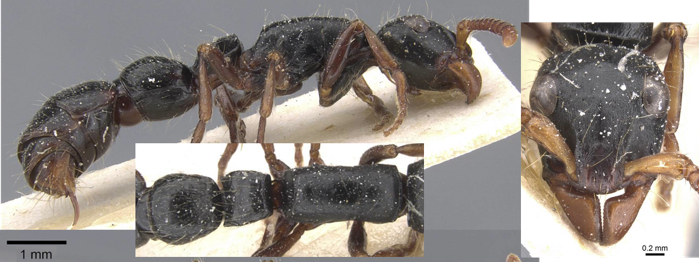 |
Cameroun & Zaïre - grandis |
| -- |  Dorsum of head between eyes
densely reticulate-punctate with a few larger shallow punctures,
without longitudinal costulate sculpture. Dorsum of mesosoma only with
1–2 pairs of setae near the humeral angles, 1–2 pairs on anterior
mesonotum and 1– 2 pairs at propodeal declivity. Anterior half of
clypeus without a median longitudinal carina. Smaller species with head Dorsum of head between eyes
densely reticulate-punctate with a few larger shallow punctures,
without longitudinal costulate sculpture. Dorsum of mesosoma only with
1–2 pairs of setae near the humeral angles, 1–2 pairs on anterior
mesonotum and 1– 2 pairs at propodeal declivity. Anterior half of
clypeus without a median longitudinal carina. Smaller species with headrelatively narrow; HW 1.18–1.36; |
Kenya southwards - persculpta |
| 6 |
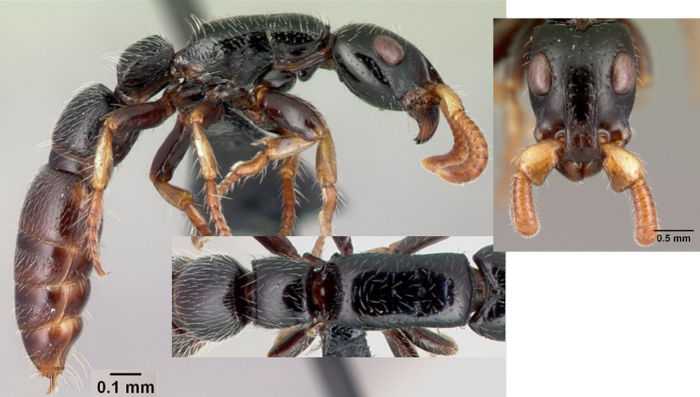 Scape very distinctively flattened and broad; HL
1.80-1.96 HW 1.32-1.48 Scape very distinctively flattened and broad; HL
1.80-1.96 HW 1.32-1.48 |
West Africa & Gabon - latiscapa |
| -- | 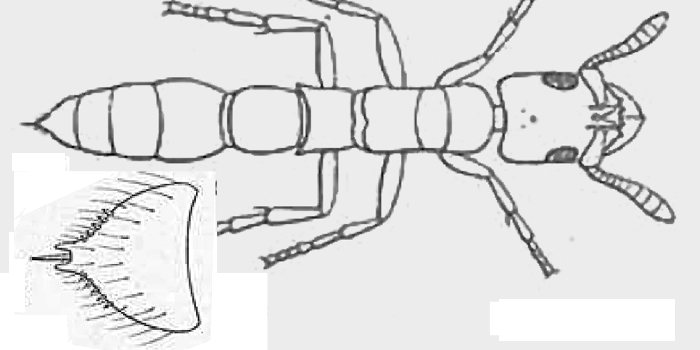 Smaller species, HW 0.93–1.07 ;
TL 7.0
mm; head narrower; sparse pubescence of short recumbent golden hairs;
reddish ochreous yellow Smaller species, HW 0.93–1.07 ;
TL 7.0
mm; head narrower; sparse pubescence of short recumbent golden hairs;
reddish ochreous yellow |
. |
| . |  |
South Africa (Natal) - marleyi |
| schoutedeni-group - amana, annettae, brunnea, dryas, fulvinodis, miniflava, occulta, rabula, schoutedeni, vepres and wilburi | . | |
| 7 |  Holotype
queen only; the
combination of its colour, complete lack of cephalic ground sculpture,
and mostly parallel-sided AII and dimensions render it immediately
recognisable. Holotype
queen only; the
combination of its colour, complete lack of cephalic ground sculpture,
and mostly parallel-sided AII and dimensions render it immediately
recognisable. |
Gabon - miniflava |
| -- | All others dark brown to black |
8 |
| 8 | 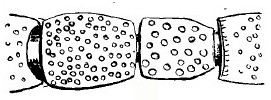 TL
4.0-4.2 mm; eyes occupy about one-third of side of head and set forward
of the mid-point; petiole node distinctly narrower in front; longer
hairs of pilosity sparse, a single pair only on the dorsal head;
bilaterally paired on humeri and in sparse
rows on the posterior margins of gaster segments; main part of body
piceous to black, except petiole and
postpetiole which are
predominantly yellow TL
4.0-4.2 mm; eyes occupy about one-third of side of head and set forward
of the mid-point; petiole node distinctly narrower in front; longer
hairs of pilosity sparse, a single pair only on the dorsal head;
bilaterally paired on humeri and in sparse
rows on the posterior margins of gaster segments; main part of body
piceous to black, except petiole and
postpetiole which are
predominantly yellow |
. |
| . |  |
Zaïre - fulvinodis |
| -- | All others wholly dark brown to
black |
9 |
| 9 | 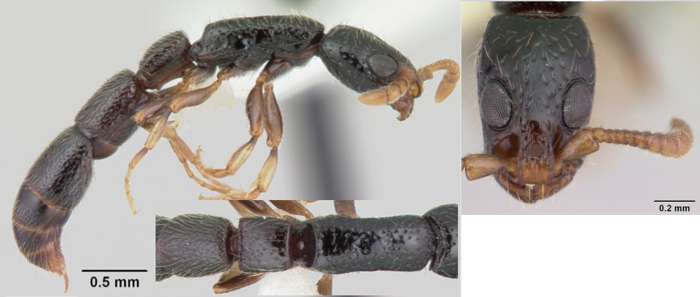 Postpetiole
relatively long and
narrow; eyes located relatively far forward Postpetiole
relatively long and
narrow; eyes located relatively far forward |
Kenya - dryas |
| -- | All others wholly dark brown to
black |
10 |
| 10 | With the head in full-face view, eyes relatively large (EI 0.30-0.35), with the outer margins strongly convex and distinctly project far beyond the outlines of the sides of the head; sides of head completely concealed in at least the median third of the eye length; in dorsal view the width of the posterior margin of the petiole distinctly wider than the anterior margin | 11 |
| -- | With the head in full-face view, eyes relatively
small (EI 0.21–0.28), shallowly convex and fail to reach, or at most
just barely interrupt the sides of the head; if the latter the petiole
in dorsal view with anterior and posterior margins near equal in width |
12 |
| 11 |
 Alitrunk glossy brown, dorsum of head with little or no
sculpture Alitrunk glossy brown, dorsum of head with little or no
sculpture |
Ghana - vepres |
| -- |
 Alitrunk
black, dorsum of head with distinct sculpture between punctures Alitrunk
black, dorsum of head with distinct sculpture between punctures |
Congo Basin - wilburi |
| 12 | 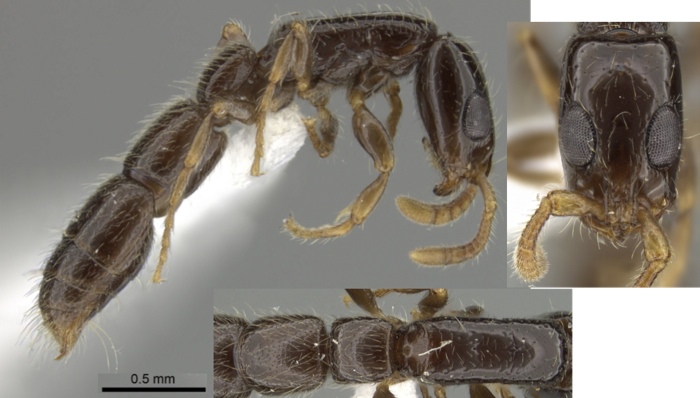 Overall smooth and
shiny; TL ca 3.5 mm; with little or no sculpturation; uniform chestnut
brown Overall smooth and
shiny; TL ca 3.5 mm; with little or no sculpturation; uniform chestnut
brown |
Zaïre & Gabon - brunnea |
| -- | Overall with distinct hair pits all over | 13 |
| 13 | Mesofemora and metafemora
brown, mesotibiae and metatibiae yellow, the two colours contrasting;
slightly larger species, HW 0.67–0.80, SL 0.32–0.34, PW 0.51–0.61; in
dorsal view the width across the anterior margin of petiole is equal to
the width across the posterior margin, or very nearly so |
14 |
| -- | Mesofemora, metafemora, mesotibiae and metatibiae all approximately the same colour, the femora and tibiae not contrasting; slightly smaller species, HW 0.49–0.59, SL 0.22–0.28, PW 0.38–0.45; but if HW 0.55 or more, SL 0.25 or more and PW 0.40 or more, then in dorsal view the width across the anterior margin of the petiole is usually obviously less than the width across the posterior margin | 15 |
| 14 |  TL
5.0 mm, HW 0.67; eyes larger and set closer together; petiole node
longer than wide but about as wide in front as behind TL
5.0 mm, HW 0.67; eyes larger and set closer together; petiole node
longer than wide but about as wide in front as behind
|
. |
| . | 
|
Democratic Republic of Congo - schoutedeni |
| -- |
HW 0.80; with smaller
eyes, set further apart; petiole wider than long (no
illustrations available) |
Tanzania - rabula |
| 15 | 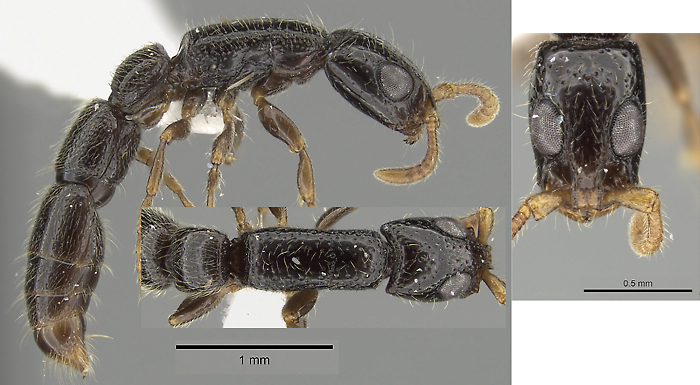 Queen only known; TL 4.6
mm, HW 0.61, HL 0.88, SL 0.32; mainly brownish-black with the
appendages lighter Queen only known; TL 4.6
mm, HW 0.61, HL 0.88, SL 0.32; mainly brownish-black with the
appendages lighterBolton & Fisher described and illustrated a possible worker; petiole slightly wider than long |
West Africa & Congo Basin - annettae |
| -- | Smaller, petiole width < 0.9 mm; hind tarsi with no more than a fine impressed line | 16 |
| 16 |  Without
dense, longitudinal striolate ground sculpture between the eyes;
petiole
with anterior and posterior margins of same width Without
dense, longitudinal striolate ground sculpture between the eyes;
petiole
with anterior and posterior margins of same width |
Gabon - occulta |
| -- |
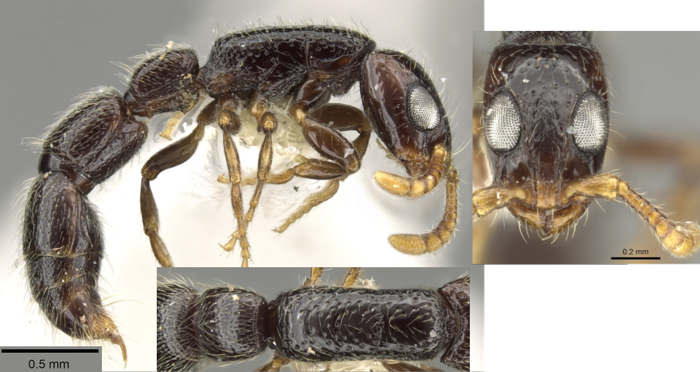 Fine
longitudinal striolate ground sculpture between the eyes; petiole with
anterior margin distinctly narrower than poterior margin Fine
longitudinal striolate ground sculpture between the eyes; petiole with
anterior margin distinctly narrower than poterior margin |
Gabon - amana |
Simopone species novaListed from Ghana, collected from cocoa by hand
sampling, at Kade, by Majer (1975); determination by Bolton. Not listed
in Bolton & Fisher (2012) |
||
|
© 2007, 2009, 2010, 2013, 2014 - Brian Taylor CBiol
FSB FRES 11, Grazingfield, Wilford, Nottingham, NG11 7FN, U.K. |
href="simopone.htm"